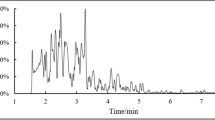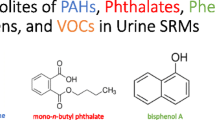Abstract
A HS-SPME method coupled with GC-MS analysis has been developed for simultaneously measuring the concentration of 10 volatile organic compounds (VOCs) (benzene, toluene, ethylbenzene, o-, m-, and p-xylene, methyl tert-butyl ether, ethyl tert-butyl ether, 2-methyl-2-butyl methyl ether, and diisopropyl ether) in urine matrix as a biomonitoring tool for populations at low levels of exposure to such VOCs. These compounds, potentially toxic for human health, are common contaminants of both outdoor and indoor air, as they are released by autovehicular traffic; some of them are also present in environmental tobacco smoke (ETS). Thus, the exposure to these pollutants cannot be neglected and should be assessed. The low limits of detection and quantification (LODs and LOQs <6.5 and 7.5 ng L–1, respectively) and the high reproducibility (CVs <4 %) make the developed method suited for biomonitoring populations exposed at low levels such as children. Further, the method is cost-effective and low in time-consumption; therefore, it is useful for investigating large populations. It has been applied to children exposed to traffic pollution and/or ETS; the relevant results are reported, and the relevant implications are discussed.


Similar content being viewed by others
References
Hansen AB, Palmgren F. VOC air pollutants in Copenhagen. Sci Total Environ. 1996;189(190):451–7.
Villanueva F, Notario A, Adame JA, Millán MC, Mabilia R, Albaladejo J. A preliminary study on ambient levels of carbonyls, benzene, toluene and xylene in the south-west of the Iberian Peninsula (Huelva coast), Spain. Environ Technol. 2013;34:289–99.
Villanueva F, Notario A, Tapia A, Albaladejo J, Cabañas B, Martínez E. Ambient levels of volatile organic compounds and criteria pollutants in the most industrialized area of central Iberian Peninsula: intercomparison with an urban site. Environ Technol. 2015;37:983–96. 2016.
Acosta Navarro JC, Smolander S, Struthers H, Zorita E, Ekman AM, Kaplan JO, et al. Global emissions of terpenoid VOCs from terrestrial vegetation in the last millennium. J Geophys Res-Atmos. 2015;119:6867–85.
Kim YM, Harrad S, Harrison RM. Concentrations and sources of VOCs in urban domestic and public microenvironments. Environ Sci Technol. 2005;35:997–1004.
Son B, Breysse P, Yang W. Volatile organic compounds concentrations in residential indoor and outdoor and its personal exposure in Korea. Environ Int. 2003;29:79–85.
Rumchev K, Brown H, Spickett J. Volatile organic compounds: do they present a risk to our health? Rev Environ Health. 2007;22:39–55.
Hinwood AL, Berko HN, Farrar D, Galbally IE, Weeks IA. Volatile organic compounds in selected micro-environments. Chemosphere. 2006;63:421–9.
WHO (World Health Organization). WHO Air quality guidelines for particulate matter, ozone, nitrogen dioxide and sulfur dioxide. Global update 2005. Summary of risk assessment. WHO Press, World Health Organization 2006. Available at http://apps.who.int/iris/bitstream/10665/69477/1/WHO_SDE_PHE_OEH_06.02_eng.pdf. Accessed 15 Jan 2016.
WHO (World Health Organization). WHO human health risk assessment toolkit: chemical hazards. IPCS harmonization project document; no.8. 2010. Available at http://www.who.int/ipcs/publications/methods/harmonization/toolkit.pdf. Accessed 15 Jan 2016
CDC (Center for Disease and Control). Fourth National Report on Human Exposure to Environmental Chemicals. 2009. Available at: http://www.cdc.gov/exposurereport. Accessed 18 Jan 2016
WHO (World Health Organization). Human biomonitoring: facts and figures. Copenhagen: WHO Regional Office for Europe, 2015. Available at: http://www.euro.who.int/__data/assets/pdf_file/0020/276311/Human-biomonitoring-facts-figures-en.pdf. Accessed 18 Jan 2016
Anderson LM, Diwan BA, Fear NT, Roman E. Critical windows of exposure for children’s health: cancer in human epidemiological studies and neoplasms in experimental animal models. Environ Health Perspect. 2000;108:573–94.
Weaver VM, Davoli CT, Heller PJ, Fitzwilliam A, Peters HL, Sunyer J, et al. Benzene exposure, assessed by urinary trans, trans-muconic acid, in urban children with elevated blood lead levels. Environ Health Perspect. 1996;104:318–23.
Barton HA, Cogliano VJ, Flowers L, Valcovic L, Setzer RW, Woodruff TJ. Assessing susceptibility from early-life exposure to carcinogens. Environ Health Perspect. 2005;113:1125–33.
Duderstadt KG. Environmental health policy and children's health. J Pediatr Health Care. 2006;20:411–3.
van Leeuwen DM, Pedersen M, Hendriksen PJ, Boorsma A, van Herwijnen MH, Gottschalk RW, et al. Genomic analysis suggests higher susceptibility of children to air pollution. Carcinogenesis. 2008;29:977–83.
Armstrong TW, Zaleski RT, Konkel WJ, Parkerton TJ. A tiered approach to assessing children’s exposure: a review of methods and data. Toxicol Lett. 2002;127:111–9.
Wild CP, Kleinjans J. Children and increased susceptibility to environmental carcinogens: evidence or empathy? Cancer Epidemiol Biomarkers Prev. 2003;12:1389–94.
WHO (World Health Organization). Global Plan of Action for Children’s Health and the Environment (2010–2015). 2009. Available at: http://www.who.int/ceh/cehplanaction10_15.pdf. Ultimo accesso: 08/04/2013. Accessed 20 Jan 2016
Smolders R, Schramm KW, Nickmilder M, Schoeters G. Applicability of noninvasively collected matrices for human biomonitoring. Environ Health. 2009;8:8.
Johnson ES, Langard S, Lin YS. A critique of benzene exposure in the general population. Sci Total Environ. 2007;374:183–98.
Protano C, Guidotti M, Manini P, Petyx M, La Torre G, Vitali M. Benzene exposure in childhood: role of living environments and assessment of available tools. Environ Int. 2010;36:779–87.
Protano C, Andreoli R, Manini P, Guidotti M, Vitali M. A tobacco-related carcinogen: assessing the impact of smoking behaviours of cohabitants on benzene exposure in children. Tobacco Control. 2012;21:325–9.
Protano C, Andreoli R, Manini P, Vitali M. Urinary trans, trans-muconic acid, and S-phenylmercapturic acid are indicative of exposure to urban benzene pollution during childhood. Sci Total Environ. 2012;435(436):115–23.
Andreoli R, Protano C, Manini P, De Palma G, Goldoni M, Petyx M, et al. Association between environmental exposure to benzene and oxidative damage to nucleic acids in children. Med Lav. 2012;103:324–37.
De Palma G, Poli D, Manini P, Andreoli R, Mozzoni P, Apostoli P, et al. Biomarkers of exposure to aromatic hydrocarbons and methyl tert-butyl ether in petrol station workers. Biomarkers. 2012;17:343–51.
Andreoli R, Spatari G, Pigini D, Poli D, Banda I, Goldoni M, et al. Urinary biomarkers of exposure and of oxidative damage in children exposed to low airborne concentrations of benzene. Environ Res. 2015;142:264–72.
IARC (International Agency for Research on Cancer). Some industrial chemicals and dyestuffs. IARC Monogr Eval Carcinog Risk Hum. 1982;29:93–149.
ATSDR (Agency for Toxic Substances and Disease Registry). Interaction profile for: Benzene, Toluene, Ethylbenzene, and Xylenes (BTEX). U.S. Department of Health and Human Services Public Health Service Agency for Toxic Substances and Disease Registry 2004.
Vainiotalo S, Riihimäki V, Pekari K, Teräväinen E, Aitio A. Toxicokinetics of methyl tert-butyl ether (MTBE) and tert-amyl methyl ether (TAME) in humans, and implications to their biological monitoring. J Occup Environ Hyg. 2007;4:739–50.
Dekant W, Bernauer U, Rosner E, Amberg A. Toxicokinetics of ethers used as fuel oxygenates. Toxicol Lett. 2001;124:37–45.
Stupp D, Gass M, Leiteritz H, Pijls C, Thornton S, Smith J, et al. Gasoline ether oxygenate occurrence in Europe, and a review of their fate and transport characteristics in the environment. Concawe Rep. 2012;4:230p.
Risticevic S, Lord H, Górecki T, Arthur CL, Pawliszyn J. Protocol for solid-phase microextraction method development. Nat Protoc. 2010;5:122–39.
Demyttenaere JC, Van Belleghem K, De Kimpe N. Biotransformation of (R)-(+)-and (S)-(−)-limonene by fungi and the use of solid phase microextraction for screening. Phytochemistry. 2001;57:199–208.
Demyttenaere JC, Vanoverschelde J, De Kimpe N. Biotransformation of (R)-(+)- and (S)-(-)-citronellol by Aspergillus sp. and Penicillium sp., and the use of solid-phase microextraction for screening. J Chromatogr A. 2004;1027:137–46.
Demyttenaere JC, Moriña RM, De Kimpe N, Sandra P. Use of headspace solid-phase microextraction and headspace sorptive extraction for the detection of the volatile metabolites produced by toxigenic Fusarium species. J Chromatogr A. 2004;1027:147–54.
Demyttenaere JC, Martínez JI, Verhé R, Sandra P, De Kimpe N. Analysis of volatiles of malt whisky by solid-phase microextraction and stir bar sorptive extraction. J Chromatogr A. 2003;985:221–32.
Demyttenaere JC, Dagher C, Sandra P, Kallithraka S, Verhé R, De Kimpe N. Flavor analysis of Greek white wine by solid-phase microextraction-capillary gas chromatography-mass spectrometry. J Chromatogr A. 2003;985:233–46.
Guidotti M, Vitali M. Determination of organotin compounds in water samples by Solid Phase Microextraction (SPME) and GC/MS. Ann Chim. 1997;87:497–504.
Guidotti M, Ravaioli G, Vitali M. Total p-nitrophenol determination in urine samples of subjects exposed to parathion and methyl-parathion by SPME and GC/MS. J High Resolut Chromatogr. 1999;22:628–30.
Guidotti M, Vitali M. Determination of urinary mercury and methylmercury by solid phase microextraction and GC/MS. J High Resolut Chromatogr. 1998;21:665–6.
Guidotti M, Ravaioli G, Vitali M. Total p-chlorophenol determination in urine samples of subjects exposed to chlorobenzene, using SPME and GC-MS. J High Resolut Chromatogr. 1999;22:427–8.
Popp P, Paschke A. Solid-phase microextraction of volatile organic-compounds using carboxen-polydimethylsiloxane fibers. Chromatographia. 1997;46:419–24.
Andreoli R, Manini P, Bergamaschi E, Brustolin A, Mutti A. Solid-phase microextraction and gas chromatography-mass spectrometry for determination of monoaromatic hydrocarbons in blood and urine: application to people exposed to air pollutants. Chromatographia. 1999;50:167–72.
Achten C, Püttmann W. Determination of methyl tert-butyl ether in surface water by use of solid-phase microextraction. Environ Sci Technol. 2000;34:1359–64.
Achten C, Kolb A, Püttmann W. Sensitive method for determination of methyl tert-butyl ether (MTBE) in water by use of headspace-SPME/GC-MS. Fresenius' J Anal Chem. 2001;371:519–25.
Alonso A, Fernández-Torroba MA, Tena MT, Pons B. Development and validation of a solid-phase microextraction method for the analysis of volatile organic compounds in groundwater samples. Chromatographia. 2003;57:369–78.
Flórez Menéndez JC, Fernández-Sánchez ML, Sánchez Uría JE, Fernández Martínez E, Sanz-Medel A. Static headspace, solid-phase microextraction, and headspace solid-phase microextraction for BTEX determination in aqueous samples by gas chromatography. Anal Chim Acta. 2000;415:9–20.
Lambropoulou DA, Albanis TA. Optimization of headspace solid-phase microextraction conditions for the determination of organophosphorus insecticides in natural waters. J Chromatogr A. 2001;922:243–55.
He Y, Wang Y, Lee HK. Trace analysis of ten chlorinated benzenes in water by headspace solid-phase microextraction. J Chromatogr A. 2000;874:149–54.
Currie LA. Limits for qualitative detection and quantitative determination. Appl Radiochem Anal Chem. 1968;40:586–93.
Skender L, Brcić I, Karacić V. Urine analysis for the evaluation of environmental exposures to aromatic hydrocarbons. Arch Environ Health. 2004;59:237–44.
ATSDR (Agency for Toxic Substances and Disease Registry). Toxicological profile for xylene. U.S. Department of Health and Human Services Public Health Service Agency for Toxic Substances and Disease Registry, 2007.
Prado C, Garrido PJF. Urinary benzene determination by SPME/GC–MS—a study of variables by fractional factorial design and response surface methodology. J Chromatogr, B. 2004;804:255–61.
Acknowledgements
The authors are thankful to the Sapienza University of Rome for financial support of the study. Grant 2014 prot. N. C26A14AZYY.
Author information
Authors and Affiliations
Corresponding author
Ethics declarations
Conflict of Interest
The authors certify that they have no affiliations or involvement with any organization or entity with any financial or nonfinancial interest in the subject matter or materials discussed in this manuscript.
Research involving Human Participants
The protocol of the study involving human participants was approved by local Ethical Committee (Policlinico Umberto I/Sapienza University of Rome; protocol code 2894).
Informed consent
Since participants were children aged 5- to 11 y old, informed consent was signed by both parents of each participant and by older children (9- to 11-y old).
Rights and permissions
About this article
Cite this article
Antonucci, A., Vitali, M., Avino, P. et al. Sensitive multiresidue method by HS-SPME/GC-MS for 10 volatile organic compounds in urine matrix: a new tool for biomonitoring studies on children. Anal Bioanal Chem 408, 5789–5800 (2016). https://doi.org/10.1007/s00216-016-9682-x
Received:
Revised:
Accepted:
Published:
Issue Date:
DOI: https://doi.org/10.1007/s00216-016-9682-x




